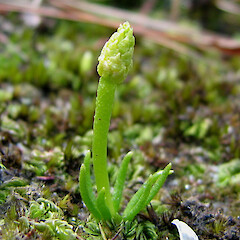Phylloglossum drummondii
Synonyms
Lycopodium sanguisorba Spring
Family
Lycopodiaceae
Flora category
Vascular – Native
Endemic taxon
No
Endemic genus
No
Endemic family
No
Structural class
Lycophytes (clubmosses, selaginella, quillworts)
NVS code
The National Vegetation Survey (NVS) Databank is a physical archive and electronic databank containing records of over 94,000 vegetation survey plots - including data from over 19,000 permanent plots. NVS maintains a standard set of species code abbreviations that correspond to standard scientific plant names from the Ngä Tipu o Aotearoa - New Zealand Plants database.
PHYDRU
Current conservation status
The conservation status of all known New Zealand vascular plant taxa at the rank of species and below were reassessed in 2017 using the New Zealand Threat Classification System (NZTCS) – more information about this can be found on the NZTCS website. This report includes a statistical summary and brief notes on changes since 2012 and replaces all previous NZTCS lists for vascular plants.
Please note, threat classifications are often suggested by authors when publications fall between NZTCS assessment periods – an interim threat classification status has not been assessed by the NZTCS panel.
- Conservation status of New Zealand indigenous vascular plants, 2017 . 2018. Peter J. de Lange, Jeremy R. Rolfe, John W. Barkla, Shannel P. Courtney, Paul D. Champion, Leon R. Perrie, Sarah M. Beadel, Kerry A. Ford, Ilse Breitwieser, Ines Schönberger, Rowan Hindmarsh-Walls, Peter B. Heenan and Kate Ladley. Department of Conservation. Source: NZTCS and licensed by DOC for reuse under the Creative Commons Attribution 4.0 International licence.
2017 | Threatened – Nationally Endangered | Qualifiers: DP, EF, PD, SO
Previous conservation statuses
2012 | Threatened – Nationally Critical | Qualifiers: EF, SO
2009 | Threatened – Nationally Critical | Qualifiers: SO, EF
2004 | Threatened – Nationally Endangered
Distribution
Indigenous. North Island, South Island. In the South Island it is only known from very old gatherings made from Marlborough and Banks Peninsula. It is now regarded as extinct at both locations. In the North Island it was once found from Te Paki south to the northern Waikato. It is now only known from scattered sites between the Surville Cliffs and Dargaville. Common in Australia.
Habitat
Coastal to lowland sites. Most often found on recently burned ground, often in gumland scrub, or overlying other similarly low, open vegetation such as that developed on clay pans and acidic soils. Also found on ultramafic soils, and heavily weathered and/or podzolised sandstones.
Detailed description
Bright yellow to yellow–green, fleshy, tufted, seasonal plant arising from a small white to pale pink ovoid to ellipsoid tuber. Plants 15–50 mm tall. Tuber 3–4 mm long, ovoid, white usually subtended by a smaller developing daughter tuber. Stem 6–9 mm, erect, mostly subterranean. Roots 1–2, fleshy, white. Leaves tufted and clustered in a rosette, fleshy, erect or spreading, 4.0–30.0 × 0.5–1.2 mm, linear, acute, terete. Fertile stem solitary; peduncle 10–50 mm tall, white, fleshy; strobilus erect, 4–10 mm; sporophylls 2–3 × 1–2 mm, ovate-triangular, acute to attenuate,. Sporangium attached to sporophyll base, 1.0–1.5 × 1.0–1.5 mm, reniform, at first pale yellow maturing cream.
Similar taxa
None.
Life cycle
The sterile blades appear in July and may persist until November (though they have usually dried off by late October). Fertile cones are produced one or two per tuft from about August to October.
Propagation technique
Difficult. Should not be removed from the wild.
Threats
This species has declined markedly as a consequence of the conversion of its preferred gumland scrub habitat to farmland, or through the loss of these habitats as a consequence of natural succession. Plants have also been lost through over collection in some smaller, vulnerable populations.
Where To Buy
Not commercially available.
Attribution
Fact Sheet Prepared by P.J. de Lange (1 November 2009). Description based on Chinnock (1998).
References and further reading
Bartlett B. 1944. Eucamptodon and Phylloglossum drummondii. Auckland Botancal Society Journal 1: 4–5.
Braggins J. 1974. Phylloglossum miniature denizen of the North. Wellington Botanical Society Bulletin 38: 28–34.
Chinnock RJ. 1998. Lycopodiaceae. Flora of Australia 48, Ferns Gymnosperms and allied groups: 66–85. ABRS/CSIRO Victoria, Australia.
NZPCN Fact Sheet citation
Please cite as: de Lange, P.J. (Year at time of access): Phylloglossum drummondii Fact Sheet (content continuously updated). New Zealand Plant Conservation Network. https://www.nzpcn.org.nz/flora/species/phylloglossum-drummondii/ (Date website was queried)









